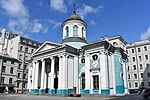Passage (department store)
Buildings and structures in Saint PetersburgCommercial buildings completed in 1848Companies nationalised by the Soviet UnionDepartment stores of RussiaDepartment stores of the Soviet Union ... and 2 more
Nevsky ProspektShopping arcades

The Passage, from the French word passage, is an élite department store on Nevsky Avenue in Saint Petersburg, Russia, which was founded in 1848. The Passage premises have long had associations with the entertainment industry and houses the Komissarzhevskaya Theatre.
Excerpt from the Wikipedia article Passage (department store) (License: CC BY-SA 3.0, Authors, Images).Passage (department store)
Nevsky prospect, Saint Petersburg
Geographical coordinates (GPS) Address Website External links Nearby Places Show on map
Geographical coordinates (GPS)
| Latitude | Longitude |
|---|---|
| N 59.935462 ° | E 30.334454 ° |
Address
Пассаж
Nevsky prospect 48
191023 Saint Petersburg (Palace District)
Saint Petersburg, Russia
Open on Google Maps










